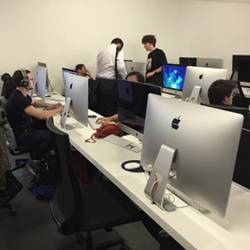
Imagine a coding school with no instructors and no formal classrooms; a school with no formal hours or textbooks, where individual effort is a recipe for failure. Imagine a school where tuition is free, and graduation takes place based on computer algorithms rather than formal grades.
Such a school actually exists. "The focus is not on gaining specific knowledge; it’s on how to innovate and think creatively," says Nicolas Sadirac, co-founder and president of Ecole 42, a coding school in Paris, France that derives its name from Douglas Adams’ book The Hitchhiker’s Guide to the Galaxy and its reference to 42 serving as the number by which all meaning is derived in life and the universe.
Says Sadirac of the school, "We don’t teach specific curriculum or a programming language. We teach students how to learn languages and how to work together to solve problems."
Ecole 42 may be a window into the future of learning, particularly in coding and software development. The school was created in 2013, with an initial €70 million (about $77 million) in funding from French billionaire Xavier Niel, founder and majority shareholder of French ISP Iliad, which operates France’s fourth-largest mobile operator under the brand name Free Mobile. Recalled Niel, "The goal was to give back. There is no tuition. Students don’t pay anything. …We want to create the best coding school in the world and make sure that anyone can attend."
Getting into Ecole 42 is an interesting process in itself: a prospective student starts with a black screen at the Ecole 42 website. If the applicant navigates through the system and solves problems adequately, he or she is invited to a four-week La Piscine, which translates to "the swimming pool" (think ‘sink or swim’) at the school’s Paris campus. During this evaluation phase, things "happen" while candidates work through coding problems: the power goes out, data disappears, teams band together and disband, and the school delivers a seemingly endless barrage of obstacles. "We are more interested in their ability to be creative and learn than what they already know," Sadirac says.
Only about 25% of the school’s 80,000 annual applicants finish the initial black-screen test. In the end, Ecole 42 accepts about 1,000 of the 3,000 students who are invited to the Piscine. Among these students (the average age is 22 and just over 10% are female), more than 40% are high school dropouts, although a few have graduated from universities like Stanford University. Remarkably, about a third of the new students have no previous coding experience.
Once at the school, students spend 15 to 16 hours a day working in small groups to solve problems in areas as diverse as gaming, robotics, cybersecurity, augmented/virtual reality, and artificial intelligence (most students live and sleep at the school). Within this environment, it is often necessary to ask for help from other students. As one student puts it: "You need to work with your peers and help each other out. 42 encourages this to a fault: you aren’t cheating if you share, or even use someone else’s code." Ultimately, "You do not feel like you are competing against your peers; rather, you are helping them succeed. It works the other way, too."
A stroll through the school, located in a former government building, is eye-opening. Approximately 1,000 iMacs fill giant coding rooms that have unusual rules. For example, there is a "quiet room" that "shuts down if there is too much noise," Niel says.
The school uses gamification methods in which students earn badges and points until they reach Level 21, or graduation. Along the way, they must engage in peer reviews and internships. A staff of 15 tosses projects at students and keeps an eye on interactions. In addition, machine learning systems constantly adapt and refine the learning process.
Students typically graduate in about three years, although there is no set timeframe; some have blown through the program in 12 months, and some may take five years or more. So far, the school boasts about 2,000 graduates who now work at about 70 companies.
Warns Niel, "This approach does not work for all students and it is not right for every situation. You could not do this type of learning everywhere. This is very specific to this school and these people."
Ecole 42 plans to open a second, 200,000-sq.-ft. campus in Fremont, CA, in November. 42 USA will follow the same blueprint as the Paris school, including paying no attention to high school grades, SAT scores, or résumés, and offering free tuition. Niel, who has a net worth of about $8.1 billion, has committed another €100 million ($111.85 million) to the U.S. campus. After that, "We haven’t figured it out. It’s something we will address as the time comes," he says.
To be sure, the Ecole 42 model could redefine and reinvent learning. It has gained the support of numerous tech executives, including Snapchat’s Evan Spiegel and Facebook’s David Marcus.
Concludes Niel: "Ecole 42 is an entire social system. When you create code, you have to work with others. We want people to be very creative and able to invent things that are different. If students all learn the same thing at the same time, it’s not possible to achieve a high level of creativity and innovation."
Samuel Greengard is an author and journalist based in West Linn, OR.



Join the Discussion (0)
Become a Member or Sign In to Post a Comment